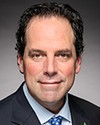Well, let me now respond as to why that is the case. That's because we are continuously looking at improving not only our certification standards and our validation standards, but also our safety standards overall.
That's why we propose additional regulations. We've moved forward most recently on flight and duty time regulations to ensure that aircrews are getting adequate rest in order to operate those aircraft. That was a safety....
We're looking at moving forward in improving the runway and safety area—that's the area at the top of and bottom of a runway—to ensure that if by chance an aircraft, because of weather, because of an operational incident, has to exit the runway, there is a certain level of ground that is pre-prepared to allow that aircraft to exit so it doesn't end up in a ravine and we have a horrible tragedy there. We're continuing to look at that.
It's not only the 705 operations, our large commercial operations, we're also very proud of our general aviation safety campaign. We've worked with the recreational operator and those associations that represent the recreational operator: What are the risks to those operators? What are the risks to those people who go down to their local airport on a Saturday to fly their aircraft for pleasure? What do they have to keep in mind in order to keep safe?
We take very seriously the Transportation Safety Board recommendations that it puts forward after air accidents. We make sure that we try to act on them as appropriately and in as timely a way as possible to ensure, and to continue to ensure, safe Canadian aviation.




